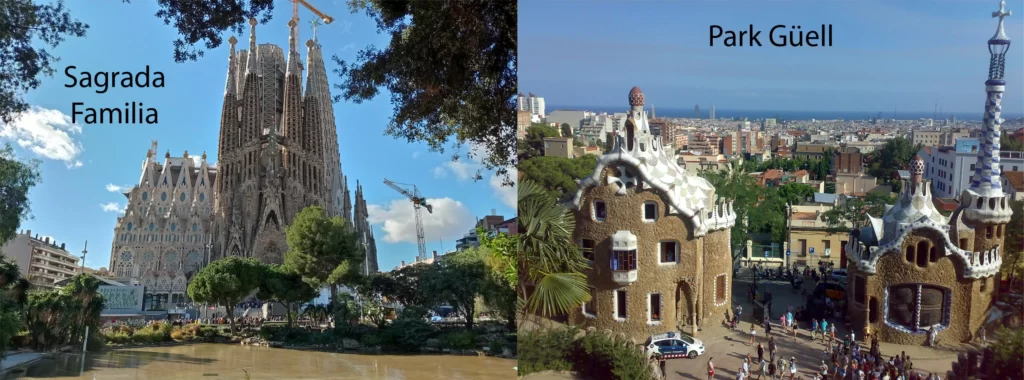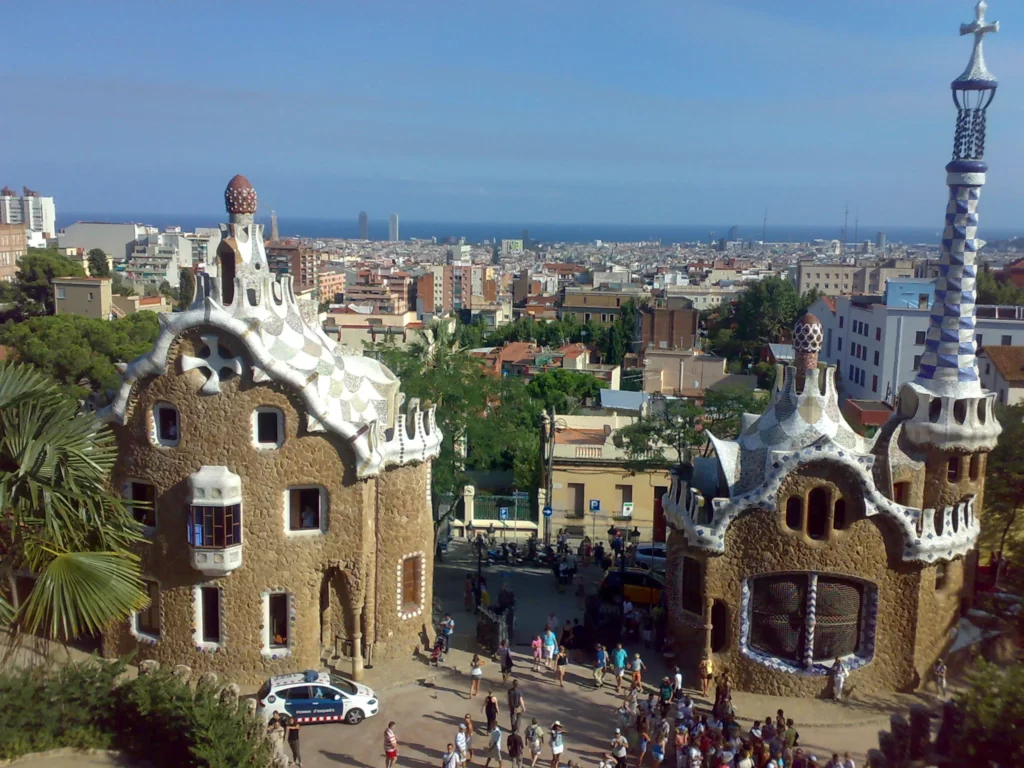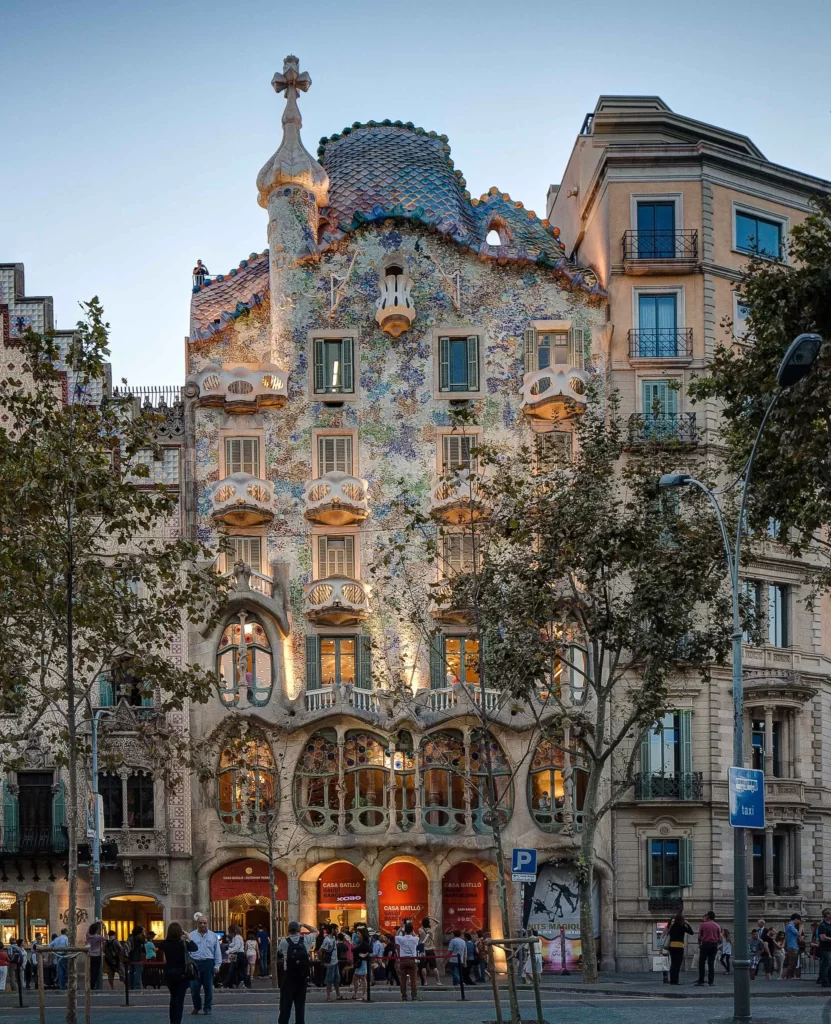If you want to know about the Permeable concrete or Islamic architecture or staircase design, please click the link.
Introduction
Antoni Gaudi (1852-1926) was a Catalan architect known for his unique and distinctive style that combined Gothic and Art Nouveau elements with inspiration from natural forms.

He is considered one of the leading figures of the Art Nouveau movement and his works, such as the Sagrada Familia and Park Güell, have become iconic landmarks in Barcelona, Spain.

Gaudi’s use of innovative engineering techniques and his attention to detail and ornamentation have earned him a reputation as a master architect and a symbol of Catalan Modernism. His works continue to inspire and influence architects and designers today.
1) Early Life and Education
Antoni Gaudí was born in 1852 in the town of Reus, Catalonia, Spain. His father, Francesc Gaudí i Serra, was a coppersmith and his mother, Antònia Cornet i Bertran, came from a family of blacksmiths. Gaudí’s family had a strong Catholic faith, which would later influence his work as an architect.
As a child, Gaudi showed an interest in nature and the arts, and was also drawn to architecture. He enrolled in the Escola Tècnica Superior d’Arquitectura in Barcelona in 1873, where he studied architecture and earned his degree in 1878.
After completing his studies, Gaudí began working as an assistant to several prominent architects in Barcelona, including Francisco de Paula del Villar, who designed the original plans for the Sagrada Familia. It was during this time that Gaudi became interested in Gothic architecture and the use of natural forms in design.
In 1883, Gaudí was given the task of taking over the Sagrada Familia project, which he would work on for the rest of his life. The project would become his most famous and enduring work, and he would dedicate much of his career to its completion.
Gaudi was also influenced by the work of other architects, such as Viollet-le-Duc, who emphasized the use of natural materials and forms in architecture.
Gaudi’s travels to Paris and Italy also exposed him to the work of other architects and artists that would influence his style, including the Art Nouveau movement.
Overall, Gaudi’s childhood experiences and family background, combined with his education and exposure to influential mentors and architectural works, helped shape his unique vision and style as an architect.
2) Major Works of Antoni Gaudí
Antoni Gaudi’s works are among the most visited tourist attractions in Barcelona, Spain. Here are some of his most famous works and their significance to his architectural style:
i) Sagrada Familia

The Sagrada Familia is Gaudi’s most famous work and a symbol of Barcelona. It is a massive, unfinished cathedral that Gaudi devoted much of his life to.
Gaudí began work on the Sagrada Familia in 1883 and continued until his death in 1926. The cathedral features a unique combination of Gothic and Art Nouveau styles, with detailed sculptures and colorful mosaics.
The cathedral is still under construction and is expected to be completed in 2026, marking the centenary of Gaudí’s death.
ii) Park Güell

Park Güell is a public park designed by Gaudí in the early 20th century. The park features a variety of structures, including terraces, gardens, and sculptures.
One of the most notable features of the park is the Dragon Stairway, which leads to the Hypostyle Room, a covered space with 86 columns. The park also features a mosaic bench that curves around a large terrace, providing stunning views of the city.
Gaudi’s use of natural forms and colorful tiles is evident throughout the park, and it is considered one of the best examples of his work.
iii) Casa Batlló

Casa Batlló is a private residence designed by Gaudí in the early 20th century. The building is located on the Passeig de Gracia, one of the most prestigious streets in Barcelona.
The facade of the building features a wave-like pattern and is decorated with colorful tiles and intricate ironwork. The interior of the building is just as unique, with curved walls and ceilings that give the impression of being inside a sea creature.
The building is now open to the public and is considered one of Gaudi’s most innovative designs.
iv) Casa Milà (La Pedrera)

Casa Milà, also known as La Pedrera, is a residential building designed by Gaudí and built between 1906 and 1912. The building’s undulating facade is made of stone and features wrought iron balconies and intricate ornamentation.
The rooftop is particularly notable, featuring sculptural chimneys and ventilation towers that resemble medieval knights. Inside the building, Gaudí created curved walls and ceilings that allowed for natural light to flow throughout the space.
Casa Milà is now open to the public and is considered one of Gaudi’s most important works.
v) Palau Güell

Palau Güell is a mansion in Barcelona designed by Gaudí for the industrialist Eusebi Güell.
The building was constructed between 1886 and 1890 and features a number of innovative architectural features, including a central atrium with a skylight that illuminates the space, and a parabolic arch that spans the entrance hall.
The building also features colorful mosaics and detailed ironwork. Palau Güell is now a UNESCO World Heritage Site and is considered one of Gaudi’s most significant early works.
vi) Colonia Güell

The Colonia Güell is a planned community located outside of Barcelona that was designed by Gaudí in the early 20th century.
The community was built to house workers at the nearby textile mill owned by Eusebi Güell. Gaudí designed a number of buildings for the community, including a church that was never completed.
The church, known as the Crypt of the Colonia Güell, is notable for its innovative use of materials and design elements, including columns that curve like tree trunks and intricate stained glass windows.
Overall, Gaudí’s works are known for their use of natural forms, intricate details, and innovative engineering techniques.
His buildings are considered a fusion of traditional Catalan architecture with modernist elements, and they continue to inspire architects and designers today.
3) Architectural Style and Techniques
Antoni Gaudi’s architectural style is characterized by his use of organic forms, colorful mosaics, and detailed sculptural elements. He drew inspiration from nature, and his designs often incorporate natural shapes, such as curves, waves, and spirals.
Gaudí believed that the forms found in nature were not only aesthetically pleasing but also structurally sound, and he sought to integrate these forms into his architectural designs.
One of the most notable features of Gaudi’s buildings is his use of colorful mosaics. He used small pieces of glass, ceramic, and stone to create intricate patterns and designs on the facades of his buildings. These mosaics added texture and depth to the buildings and helped to create a sense of movement and rhythm.
Gaudí’s designs also feature a number of sculptural elements, including detailed carvings, ornamental ironwork, and sculptural chimneys.
These elements served both a decorative and functional purpose, helping to support the structure of the building and enhance its aesthetic appeal.
In addition to his use of organic forms and decorative elements, Gaudí was also known for his innovative engineering techniques. He used the catenary arch, a structural design that uses the natural curve of a hanging chain to create a stable arch, in many of his buildings.
This technique allowed Gaudí to create structures that were both visually stunning and structurally sound, and it became one of his signature design elements.
Gaudí also used reinforced concrete, a relatively new building material at the time, in many of his designs. He experimented with different forms and shapes, pushing the limits of what was possible with the material.
His use of reinforced concrete allowed him to create thin, delicate structures that would have been impossible with traditional building materials.
Overall, Gaudí’s unique architectural style was characterized by his use of organic forms, colorful mosaics, detailed sculptural elements, and innovative engineering techniques.
His designs continue to inspire architects and designers today, and his buildings remain some of the most celebrated and visited in the world.
4) Gaudí’s Impact on Barcelona’s Urban Landscape
Gaudí’s impact on Barcelona’s architecture and urban landscape:
Antoni Gaudi’s architectural works have had a profound impact on the city of Barcelona, shaping its urban landscape and contributing to its unique character.
Gaudí’s designs incorporated elements of Catalan culture and identity, drawing on traditional materials and techniques to create buildings that were both innovative and deeply rooted in the local context.
Gaudí-related sites and landmarks in Barcelona:
Barcelona is home to a number of landmark buildings and sites that are associated with Gaudí, including the Sagrada Familia, Park Güell, and Casa Batlló.
The Sagrada Familia, in particular, is one of the most visited tourist attractions in the city, drawing millions of visitors each year to marvel at its towering spires and intricate sculptural details.
Other notable Gaudí-related sites in Barcelona include the Casa Milà (also known as La Pedrera), which was designed by Gaudí in the early 20th century and is now a UNESCO World Heritage Site.
The Palau Güell, a mansion that was also designed by Gaudí, is another popular attraction in the city.
Cultural and economic impact of Gaudí’s works on Barcelona:
The cultural and economic impact of Gaudí’s works on Barcelona cannot be overstated. His buildings have become icons of the city, attracting visitors from all over the world and contributing to the city’s reputation as a hub of art and culture.
In addition to their cultural significance, Gaudí’s works have also had a significant economic impact on Barcelona.
The millions of tourists who visit Gaudí-related sites each year contribute billions of dollars to the city’s economy, supporting local businesses and providing jobs for residents.
Gaudí’s influence on Barcelona’s architecture and urban landscape extends far beyond his own buildings, as well.
His innovative designs and use of local materials and techniques have inspired generations of architects and designers, helping to shape the city’s built environment in countless ways.
5) Legacy and Influence
Antoni Gaudi’s work had a significant impact on the Catalan Modernism movement and the broader Art Nouveau movement. His innovative use of materials, organic forms, and colorful ornamentation helped to define these movements and set them apart from traditional architectural styles.
Gaudí’s work was particularly influential in Catalonia, where he is still celebrated as a national icon. His designs for the Sagrada Familia and other buildings in Barcelona helped to define the city’s modernist architecture and put it on the map as a center of artistic and cultural innovation.
Beyond Catalonia, Gaudí’s work also had a broader impact on the Art Nouveau movement. His use of natural forms and innovative engineering techniques helped to define the movement’s emphasis on organic design and experimentation with new materials and technologies.
Gaudí’s work was admired by many contemporary architects and designers, and his influence can be seen in the work of artists such as Hector Guimard, Victor Horta, and Louis Comfort Tiffany.
Today, Gaudí’s work continues to inspire architects and designers around the world. His innovative use of materials, organic forms, and sculptural elements remains a source of inspiration for those seeking to push the boundaries of architecture and design.
Contemporary architects and designers who have been influenced by Gaudí’s work include Frank Gehry, Zaha Hadid, and Santiago Calatrava.
These designers have continued to build on Gaudí’s legacy, creating innovative, organic structures that reflect the same spirit of experimentation and innovation that defined his work.
6) Gaudí’s Collaborators and Assistants
Antoni Gaudi worked with a team of collaborators and assistants throughout his career. His team consisted of architects, engineers, sculptors, and craftsmen who helped him bring his designs to life.
Many of his collaborators were fellow Catalan artists and artisans who shared his passion for Art Nouveau and Modernisme.
One of Gaudí’s most important collaborators was Joan Bergós i Massó, an engineer who worked closely with him on many of his most famous projects.
Bergós i Massó was instrumental in helping Gaudí realize his vision for the Sagrada Familia, using innovative engineering techniques to create the soaring arches and intricate structural designs that are now iconic features of the building.
Another key collaborator was Josep Maria Jujol, a fellow Catalan architect and designer who worked with Gaudí on a number of projects, including the Park Güell and Casa Batlló.
Jujol’s contributions to these projects included the colorful mosaics and sculptural elements that are characteristic of Gaudí’s designs.
Other notable collaborators included the sculptor Carles Mani i Roig, who worked with Gaudí on the Casa Batlló, and the ceramicist Llorenç Matamala, who helped create the intricate tilework that is a hallmark of many of Gaudí’s buildings.
Legacy of Gaudí’s collaborators and assistants
Gaudí’s collaborators and assistants played a significant role in bringing his designs to life and helping him realize his vision for his buildings.
Many of these collaborators went on to have successful careers of their own, and their work continues to be celebrated today.
Joan Bergós i Massó, for example, went on to become a renowned engineer in his own right, and his contributions to the Sagrada Familia are now recognized as a key part of the building’s legacy.
Josep Maria Jujol also went on to have a successful career as an architect and designer, and his work continues to be celebrated as a key part of the Catalan Modernisme movement.
In addition to their individual legacies, Gaudí’s collaborators and assistants also contributed to the enduring legacy of Gaudí himself.
Their work helped to bring his designs to life, and their contributions have helped to ensure that Gaudí’s unique vision will continue to be celebrated and studied for generations to come.
7) Controversies and Criticisms of Gaudí’s Works
While Gaudí’s work is celebrated for its innovation and unique aesthetic, it has also faced criticism from some quarters. One common criticism is that Gaudí’s designs are too ornate and decorative, prioritizing form over function.
Critics have argued that Gaudí’s buildings are difficult to live or work in and that their intricate designs can be overwhelming or distracting.
Another criticism of Gaudí’s work is that it can be culturally insensitive or appropriative. Some have argued that Gaudí’s use of traditional motifs and materials in his designs can be seen as appropriating or exoticizing other cultures.
Gaudí’s projects have also been subject to controversy over the years. One of the most significant controversies surrounding Gaudí’s work is the ongoing construction of the Sagrada Familia.
Some critics have argued that the project has become too commercialized and that its continued construction is at odds with Gaudí’s original vision.
There have also been controversies surrounding some of Gaudí’s other projects. For example, the construction of Park Güell was fraught with financial difficulties and legal disputes, and the project was ultimately scaled back from its original vision.
In response to criticism and controversy, Gaudí and his supporters have argued that his designs are meant to be both functional and beautiful.
Gaudí believed that form and function were interconnected, and that a building’s design should be guided by its intended purpose.
Gaudí’s defenders have also argued that his use of traditional motifs and materials is meant to celebrate and honor the cultures that inspired him.
They argue that Gaudí’s work is not appropriative but rather an homage to the rich cultural heritage of Catalonia and other regions.
In response to the controversies surrounding the Sagrada Familia, Gaudí’s supporters have argued that the project is a living testament to his legacy and a tribute to his vision of creating a structure that is both spiritually and aesthetically meaningful.
Overall, while Gaudí’s work has faced criticism and controversy over the years, his legacy remains an important and enduring part of architectural history.
His innovative designs and unique aesthetic continue to inspire architects and designers around the world, and his buildings remain some of the most celebrated and visited in the world.
8) Conclusion
Antoni Gaudí was a Catalan architect and one of the leading figures of the Art Nouveau movement.
His unique architectural style, characterized by organic forms, colorful mosaics, and detailed sculptural elements, has had a lasting impact on the world of architecture.
Gaudí’s most famous works include the Sagrada Familia, Park Güell, and Casa Batlló, which are renowned for their innovative engineering techniques and their significance to Gaudí’s architectural style.
Despite criticisms and controversies surrounding some of Gaudí’s design choices, efforts to preserve and restore his works continue to this day.
The ongoing construction of the Sagrada Familia is a testament to the enduring legacy of Gaudí’s work and his impact on the Catalan Modernism movement and the broader Art Nouveau movement.
Many contemporary architects and designers have been influenced by Gaudí’s work, and his unique vision continues to inspire new generations of designers and artists.